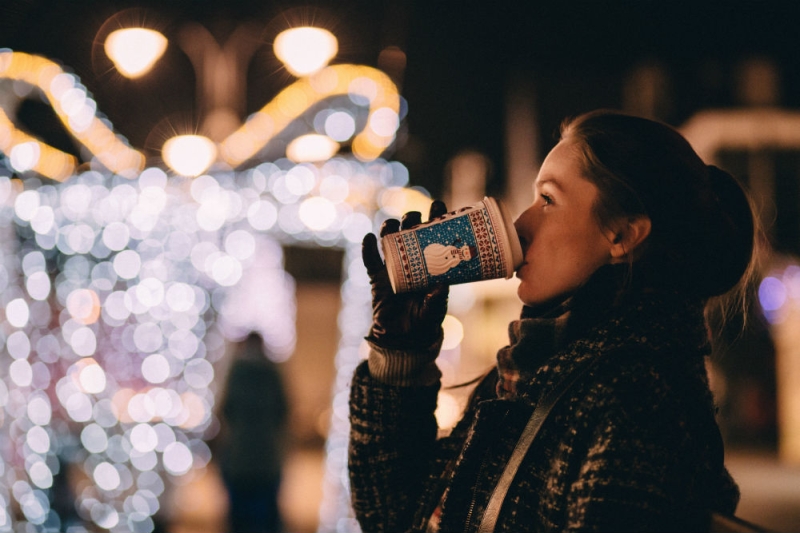
New Year is traditionally considered a holiday that gathers family and friends around the common table at home. However, the opportunity to change the usual environment and go on a trip is becoming more and more attractive. The beginning of 2020 will give us eight days off: they may not be enough for a long trip, but for a holiday in Russia or Europe – just right! We have compiled for you a list of places where you can celebrate the New Year relatively inexpensively and spend the New Year holidays interestingly.
1. Karelia, Russia
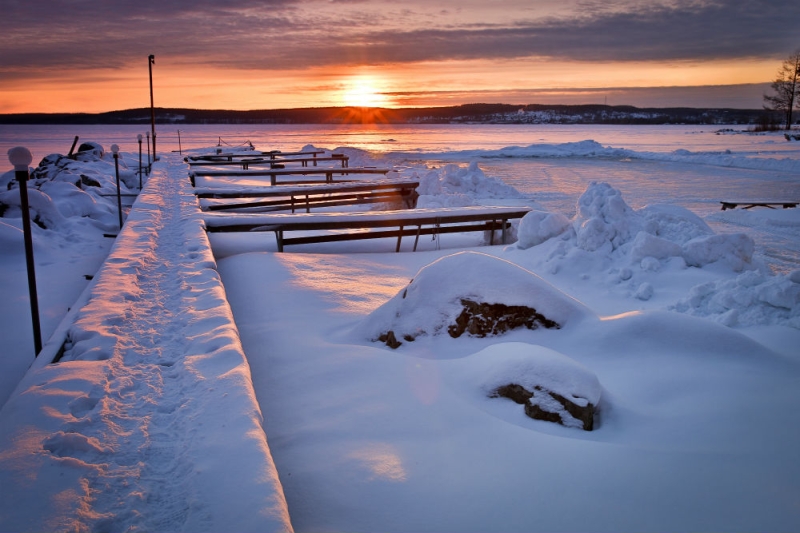
- Flight to Petrozavodsk 31.12 – 9.01 from 5,600 rubles from Moscow
- Accommodation: hostel from 4,500 rubles for 9 nights per person
- Hotel 4*: from 45,000 rubles for 9 nights per person
New Year in Karelia is a real winter fairy tale: ice-bound rivers, fluffy fir trees covered with snow sparkling in the sun, the crunch of snowdrifts underfoot and clean air. There are no high mountains in Karelia, but there is still the opportunity to go skiing – at the Yagola, Spasskaya Guba and Kurgan resorts. The winter nature of Karelia will make you feel like a child in the magnificent castle of the Snow Queen, where it is easy to forget about everything, play snowballs and go down the slides. And then warm up by the fireplace in a cozy cottage!
What to see and visit:
- Museum of Wooden Architecture on the Kizhi Island.
- Ruskeala Marble Canyon.
- Kivach Waterfall.
- Paanajärvi National Park.
What to try:
The traditional cuisine of Karelia dates back to the times of Ancient Rus’. Due to its geographical location, it abounds in dishes made from fish, mushrooms and wild berries.
- Salmon soup with cream.
- Kalitki – open Karelian pies filled with potatoes, cereals or cottage cheese.
- Maitokalakeito – fish baked with milk.
- Steamed lingonberries – an ancient Karelian dessert.
2. Riga, Latvia
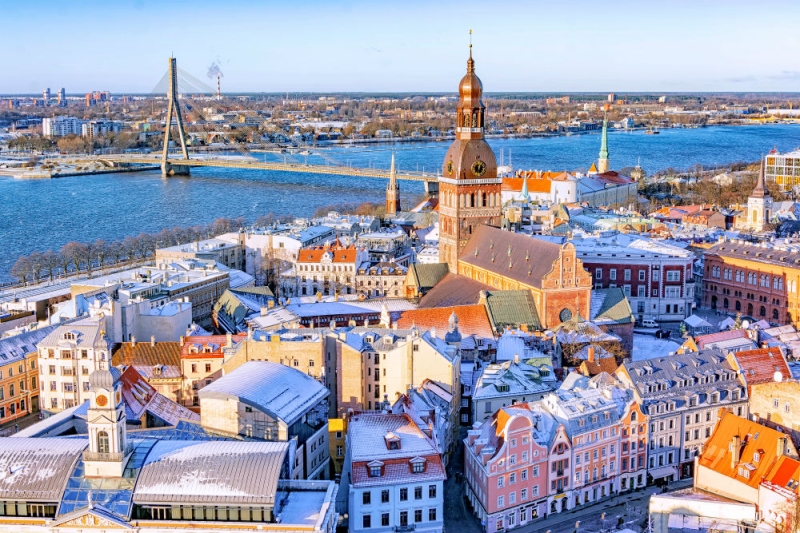
- Flight 31.12 – 9.01 from 16,700 rubles from Moscow
- Accommodation: hostel from 5,600 rubles for 9 nights per person
- Hotel 3*: from 18,900 rubles for 9 nights per person
Riga, like other European capitals, is carefully decorated for the New Year. Lithuanians love handmade goods, so shop windows and cafes are decorated not only with garlands, but also with cute handmade trinkets. The old town with narrow streets and beautiful buildings from different eras invites you for long walks. And if somewhere in the middle of the journey you feel a little cold, pop into the fairgrounds for a cup of hot mulled wine or make yourself comfortable in one of the cozy cafes nearby. By the way, prices in Riga are very affordable even during the holiday period, which, coupled with a fairly short flight, makes the capital of Latvia an excellent option for visiting during the New Year holidays.
What to see and visit:
- Old Town.
- St. Peter’s Church. The observation deck on the cathedral tower offers panoramic views of the old city.
- The Dome Cathedral, where organ concerts are held. The schedule of events can be found here.
- Art Nouveau quarter with beautiful Art Nouveau houses.
- Ancient city market .
- Miera iela street, which has the reputation of the most hipster street in the world.
What to try:
Most of the national recipes of Latvian cuisine were formed under the influence of German, Lithuanian, Russian, Belarusian and Estonian cuisines. The most popular products in Latvia, which form the basis of a huge number of dishes, are peas, beans, potatoes, vegetables, cereals, meat, fish and seafood.
- Boiled gray peas with cracklings and bacon.
- Yanov cheese – cheese made from cottage cheese with the addition of eggs and caraway seeds.
- Cake “Vetsriga”. Outwardly it resembles a profiterole, only inside there is not custard, but a filling of cottage cheese and cream.
- Riga balsam is a strong alcoholic drink made from herbs, roots, berries and fruits. Since ancient times, it has been considered an excellent medicinal drink, which perfectly helps with colds.
- Blood pancakes. In shape and appearance they are ordinary pancakes, only brown. When preparing the dough, strained pork or deer blood is added instead of milk. Served with butter or jam.
- Sklandrausis – an open pie with potato and carrot filling. One of the obligatory dishes of the Latvian Christmas table.
- And for dessert – bread soup, which is prepared from ground rye bread with sugar, cinnamon and dried fruits. When serving, the dish is topped with whipped cream.
3. Budapest, Hungary
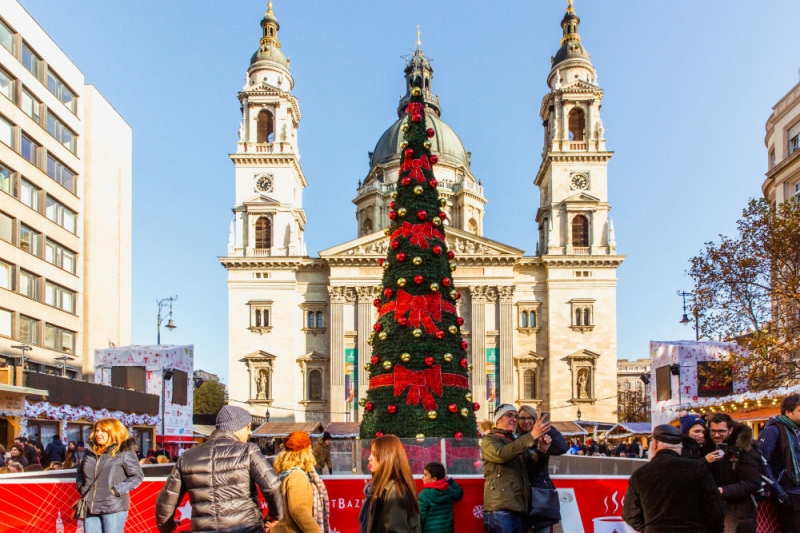
Photo: Jane Biriukova/Shutterstock.com
- Flight 31.12 – 9.01 from 14,600 rubles from Moscow
- Accommodation: hostel from 9,500 rubles for 9 nights per person
- Hotel 3*: from 29,800 rubles for 9 nights per person
In Hungary there is a belief that on New Year’s Eve an evil spirit comes into the cities, and you can drive it away with bright lights, fireworks and loud laughter. Hence the brightly decorated streets of the city and the rich program of New Year’s festivities. Tours of medieval castles, walks around the city and shopping – during the day, and at night – noisy parties with DJ performances in Budapest clubs.
What to see and visit:
- The building of the Hungarian Parliament.
- Buda Castle.
- Fisherman’s Bastion.
- Baths. The most popular: Széchenyi, Lukacs, Kiray, Rudas, Gellert.
- Memorial “Shoes on the Danube Embankment”.
- Zoo.
- Ruin bars.
What to try:
In Hungary they love to eat hearty food, so many national dishes are quite fatty and high in calories. Butter and vegetable oils are not held in high esteem here, so animal fat is usually used for cooking.
- Goulash is the most famous Hungarian dish. Thick soup with stewed meat, potatoes and paprika.
- Halasle – spicy tomato fish soup made from several types of river fish.
- Paprikash – stewed chicken or veal in sour cream sauce with paprika.
- Fazelek – the basis of the dish is paprika, add zucchini, cabbage, beans, lentils, tomatoes to taste , potatoes or celery.
- Turosh chusa is a rather unusual dessert for European cuisine made from noodles, cottage cheese, sour cream and cracklings.
- Tokaj wine is a white dessert wine that Hungarians are very proud of. Grapes are grown and the drink is produced in the northeast of the country.
4. Tallinn, Estonia
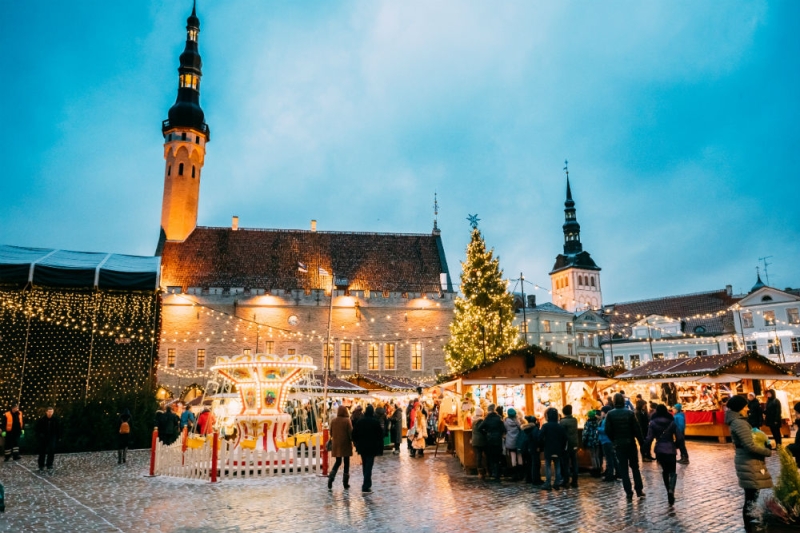
- Flight 31.12 – 9.01 from 20,400 rubles from Moscow
- Accommodation: hostel from 8,900 rubles for 9 nights person
- Hotel 3*: from 34,200 rubles for 9 nights per person
Thematic New Year’s excursions to museums and ancient castles of the capital of Estonia take tourists to the real Middle Ages. Christmas markets are open until January 7, and artists give performances and concerts on the streets of the city. By the way, last year the New Year’s market in Tallinn was recognized as the best in Europe.
What to see and visit:
- Old town.
- One of the oldest operating pharmacies in Europe. The establishment was opened in 1422 and still retains the ambience of the Middle Ages.
- The oldest European town hall.
- Restaurant « Three Dragons” in the town hall, in which the atmosphere of the Middle Ages is recreated with maximum accuracy. Instead of lamps, the room is illuminated by candles, and there are no cutlery.
- Area of two-story wooden houses with stove heating.
- Katarina Lane.
- Kadriorg palace and park ensemble.
What to try:
Estonian national dishes are based on pork, fish, vegetables and black bread, the combination of which produces simple and satisfying dishes.
- Estonians’ favorite winter soup is Mulgikapsad – made from pork, potatoes and cabbage.
- Milk and fish soup. Flounder, pink salmon or cod are often used as a base, but we recommend trying milk soup made from fresh herring.
- Beer soup with bread. The composition also includes milk, cream and sugar.
- Silgud pekiketmes – fish in a sauce made from lard, milk, onions and spices.
- A traditional Christmas dish is blood sausage. Eaten with cranberry jam, sour cream or butter.
- Oatmeal jelly with milk.
Istanbul, Turkey
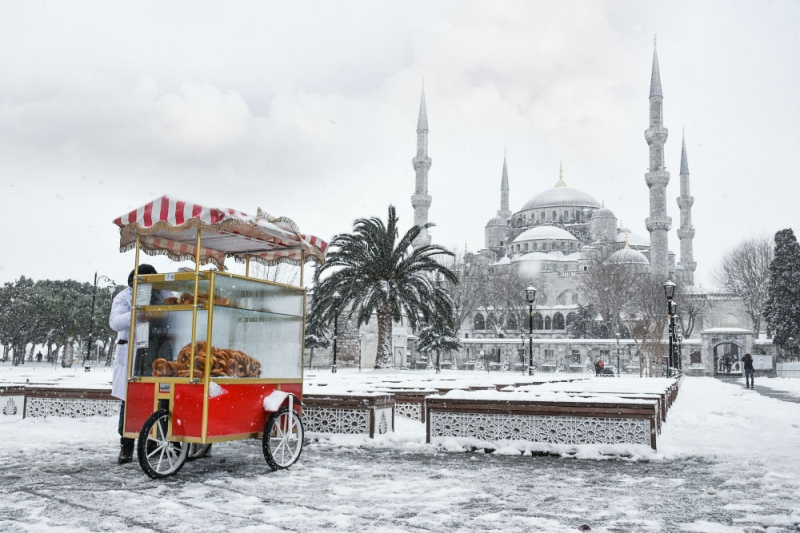
- Flight 12/31 – 01/9 22,500 rubles from Moscow
- Accommodation: hostel from 4,200 rubles for 9 nights per person
- Hotel 3*: from 11,500 rubles for 9 nights per person
What to see and visit:
- Sultanahmet Mosque.
- Hagia Sophia Museum.
- Galata Tower and observation deck at the top.
- Basilica Cistern.
- Grand Bazaar.
- Take a boat ride on the Bosphorus.
- The famous Turkish baths of Suleymaniye.
Despite the fact that Turkey is a Muslim country, the tradition of celebrating the New Year has gradually taken root in big cities. Huge Christmas trees are decorated in the squares, fireworks are set off over the Bosphorus on New Year’s Eve, and there are no empty seats in clubs and restaurants.
A win-win gift option for the New Year is a Milli Piyango lottery ticket. On the last evening of the outgoing year, the country’s National Lottery is giving away 70 million liras. Turks buy tickets in droves, and on the evening of December 31st they gather at home and watch the live broadcast of the drawing.
What to try:
The culinary traditions of Turkey have absorbed the motifs of the national cuisines of the Arab, Balkan and Caucasian peoples. Turkish cuisine is varied and balanced: it abounds in dishes of meat, mainly grilled, and fish (grilled or baked), as well as cereals and vegetables. And rich soups, of which there are at least ten types on the menu of Turkish restaurants, will help you warm up and gain strength for long walks through the districts of Istanbul.
- Turkish breakfast or kahvalti is not one dish, but many. The table is served with 5-10 plates, which usually contain bread, sliced cucumbers and tomatoes, several types of cheese, olives, honey, eggs, jam, tea or coffee.
- Simit – bagel with sesame seeds. They are often sold in trays on the street with or without fillings.
- Dolma – the idea of cooking is similar to our cabbage rolls, only instead of cabbage leaves in Turkey they use grape leaves, and rice is used for the filling and vegetables, sometimes also adding minced meat.
- Borek is a juicy pie made from thin puff pastry, with cheese, meat, potatoes, onions or vegetables placed between the layers.
- Balyk ekmek – a fish sandwich, complemented with lettuce, onions and tomatoes
- Dondurma – Turkish ice cream made from milk, sugar and mastic. It is usually served accompanied by a mini-performance staged by street vendors. During the cold season, the most convenient place to enjoy ice cream is in a cafe.
- Turkish tea – while walking around the city, you can often see city residents sitting in open cafes. On the table in front of them there is almost always a two-story teapot and small transparent cups, reminiscent of tall curved glasses, with strong black tea. Turks drink this tea at any time of the year, always hot and usually sweet.
- Turkish coffee. Coffee is brewed in Turks on hot sand or coals. It is better to talk about how much sugar to add before placing an order: it is added during preparation, and you risk getting traditionally strong and very sweet coffee.
- Salep – traditional winter drink. It is made from flour obtained from orchid roots, milk and sugar, served with cinnamon. Coconut or nuts may also be added.
* Prices for flights and accommodation are indicated at the time of writing. The cost indicated in the material and the final price may differ.

